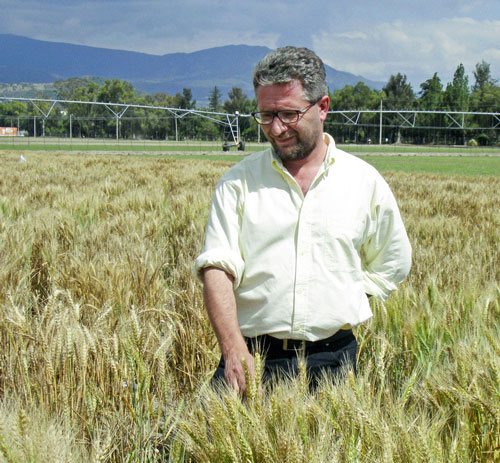Heat and drought are a major cause of wheat yield losses worldwide, problems that scientists predict will worsen due to climate change.
As a wheat physiologist, Matthew Reynolds works to bolster crop yields and improve the capacity of wheat to survive stressful conditions, particularly in developing countries.

Reynolds, who plays a leading role in several international wheat initiatives, including the Heat and Drought Wheat Improvement Consortium (HeDWIC) and the International Wheat Yield Partnership (IWYP), has developed new wheat lines based on combining complementary physiological traits.
Some of this work is detailed in a book entitled “Climate Change and Crop Production,” which he was commissioned to edit.
In addition to improving wheat drought resilience, Reynolds, who also serves as a consultant for Bayer Crop Science, has developed physiological approaches for improving the yield potential of wheat, work that will underpin the new IWYP initiative, which has so far attracted more than US $50 million in funding.
He shared his views in the following interview after being named distinguished scientist.
Q: What provides inspiration for your work?
What inspires me about working for CIMMYT is how we apply science to real life problems by participating in a very exciting chain of events that preferentially benefits many of the least privileged members of society. Because of CIMMYT’s multicultural character and because we’re a focal point of applied wheat and maize research in the world, scientists at CIMMYT understand the agricultural problems of the developing world in quite a unique way.
Q. What is your most significant achievement?
The achievement I’m most satisfied about is that we’ve been delivering improved wheat technologies to national governments using a physiological approach – that’s something that 25 years ago nobody would have believed was possible. Our first intervention was to show the value of measuring wheat canopy temperature and now it’s a tool that everyone is adopting. Thermal imaging is an offshoot – it’s a very robust tool for measuring plant temperature. It helps us determine whether a plant is adapted when it is “cool” or if there’s something wrong with it when it’s too “warm.” It’s a wonderful diagnostic tool, kind of like a doctor’s stethoscope, except we can even measure it remotely now from the air on thousands of plots at once.
Q: What role does agriculture play in poverty alleviation?
While we can do something about the fact that almost one billion people go hungry globally, agriculture is only a small part of that equation. There are a lot of other elements that we have no control over – market forces, foreign policy and natural phenomena like climate instability – all of which can neutralize our efforts. The overarching incentive for our work was defined by the late CIMMYT wheat breeder and Nobel Peace Prize winner Norman Borlaug, who famously said: “I cannot sit idly by in the midst of abject poverty and hunger and human misery.”
Q: What is the biggest challenge the world faces?
I think the challenge the world at large faces is to work towards greater unity and equality of opportunity. CIMMYT is in a sense the Red Cross of resources for farmers, but we try to pre-empt their problems and make an investment in their future. It’s been reaffirmed recently that the fundamental basis for sustainable economic growth is a vibrant agricultural sector. Our overarching aim is food security for all, focusing especially on resource-poor consumers and farmers. As a society, we expend enormous effort on controlling natural resources such as land, water, and minerals – irrespective of the cost and conflict that this causes, while, ironically, sustaining the planet’s resource base is secondary at best. That was perhaps justifiable before the advent of good communication and international cooperation, but it makes no sense anymore, especially with a crowded planet. I suppose it’s always much harder to get people to unite – something Borlaug was good at, although not without considerable effort.
Q: What is Borlaug’s legacy?
His main legacy in my opinion is making people conscious of humanitarian problems and implementing real solutions with absolute dedication. This is something most politicians and leaders only pay lip service to, to avoid upsetting the status quo, which is basically a massive and growing inequality in the world. While I was not raised a Catholic, I read a wonderful quote recently from Pope Francis that relates very much to CIMMYT’s mission. He said at his inauguration: “While the income of a minority is increasing exponentially, that of the majority is crumbling. This imbalance results from ideologies which uphold the absolute autonomy of markets and financial speculation, and thus deny the right of control to states, which are charged with providing for the common good.” At CIMMYT we are still — at least for now – charged with providing for the common good; let’s hope we can maintain that legacy.
 Innovations
Innovations